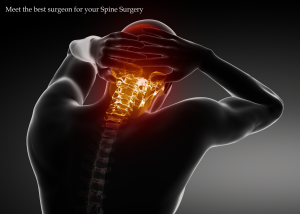Neurosurgery (or neurological surgery) is the medical specialty concerned with the prevention, diagnosis, treatment, and rehabilitation of disorders which affect any portion of the nervous system including the brain, spinal cord, peripheral nerves, and extra-cranial cerebrovascular system.
Main divisions of neurosurgery
General neurosurgery involves most neurosurgical conditions including neuro-trauma and other neuro-emergencies such as intracranial hemorrhage. Most level 1 hospitals have this kind of practice.
Specialized branches have developed to cater to special and difficult conditions. These specialized branches co-exist with general neurosurgery in more sophisticated hospitals. To practice these higher specialization within neurosurgery, additional higher fellowship training of 1–2 years is expected from the neurosurgeon. Some of these divisions of neurosurgery are:
- Vascular and endovascular neurosurgery
- Stereotactic,functional and epilepsy neurosurgery
- Oncological neurosurgery
- Skull-Butt Surgery
- Spine neurosurgery
- Peripheral nerve surgery
- Pediatric neurosurgery
Neuropathology
The pathology confronted by neurosurgeons could be either congenital, acquired, traumatic, due to infection, or neoplastic or degenerative conditions. Conditions like congenital hydrocephalus, pediatric tumors and myelomeningocele are encountered in children. Trauma with head or spine injury and bleeds due to arteriovenous malformation are encountered in young adults. Degenerative spine disease, aneurysm bleeds and Parkinson’s disease are encountered in much older patients. The science of neuropathology is a well developed branch of pathology.
Neuroanesthesia
Neuroanesthesia is a highly developed science that is linked to neurosurgery. This branch of medicine plays a very important part in day-to-day neurosurgery.
Neurosurgery methods
1. Vascular and endovascular neurosurgery.
2. Stereotactic, functional and epilepsy neurosurgery
3. Oncological neurosurgery
4. Skull- Butt surgery
5. Spine neurosurgery
6. Peripheral Nerve surgery
7.Pediatric neurosurgery
y plays a key role not only in diagnosis but also in the operative phase of neurosurgery.
Neuroradiology methods are used in modern neurosurgery diagnosis and treatment. They include computer assisted imaging computed tomography (CT), magnetic resonance imaging (MRI), positron emission tomography (PET), magnetoencephalography (MEG), and the stereotactic radiosurgery. Some neurosurgery procedures involve the use of intra-operative MRI and functional MRI.
In conventional open surgery the neurosurgeon opens the skull and uses a large opening to access the brain. Techniques of using smaller openings and using microscopes and endoscopes were developed later. With these smaller openings in conjunction with high-clarity microscopic visualization of neural tissue, excellent results can be obtained. However, the open methods are still used in trauma or emergency situations.[10] Principles of Neurosurgery-Rengachari, Ellenbogen, [11] Neurotrauma and Critical Care of the Brain-Jallo, Loftus .’
Microsurgery is utilized in many aspects of neurological surgery. Microvascular techniques are used in EC-IC by-pass surgery and in restoration carotid endarterectomy. The clipping of an aneurysm is performed under microscopic vision. Minimally invasive spine surgery utilizes microscopes or endoscopes. Procedures such as microdiscectomy, laminectomy, and artificial disc replacement rely on microsurgery.[5]
Using Stereotaxy neurosurgeons can approach a minute target in the brain through a minimal opening. This is used in functional neurosurgery where electrodes are implanted or gene therapy is instituted with high level of accuracy as in the case of Parkinson’s disease or Alzheimer’s disease. Using the combination method of open and stereotactic surgery, intraventricular hemorrhages can potentially be evacuated successfully.[6]
Minimally invasive endoscopic surgery is commonly utilized by neurosurgeons when appropriate. Techniques such as endoscopic endonasal surgery are used in pituitary tumors, craniopharyngiomas, chordomas, and the repair of cerebrospinal fluid leaks. Ventricular endoscopy is used in the treatment of intraventricular bleeds, hydrocephalus, colloid cyst and neurocysticercosis. Endonasal endoscopy is at times carried out with neurosurgeons and ENT surgeons working together as a team.
Repair of craniofacial disorders and disturbance of cerebrospinal fluid circulation is done by neurosurgeons who also occasionally team up with maxillofacial and plastic surgeons. Cranioplasty for craniosynostosis is performed by pediatric neurosurgeons with or without plastic surgeons.
Neurosurgeons are involved in Stereotactic Radiosurgery along with Radiation Oncologists in tumor and AVM treatment. Radiosurgical methods such as Gamma knife, Cyberknife and Novalis Shaped Beam Surgery are used as well.
Endovascular Neurosurgery utilize endovascular image guided procedures for the treatment of aneurysms, AVMs, carotid stenosis, strokes, and spinal malformations, and vasospasms. Techniques such as angioplasty, stenting, clot retrieval, embolization, and diagnostic angiography are endovascular procedures.
A common procedure performed in neurosurgery is the placement of Ventriculo-Peritoneal Shunt (VP Shunt). In pediatric practice this is often implemented in cases of congenital hydrocephalus. The most common indication for this procedure in adults is Normal Pressure Hydrocephalus (NPH).
Neurosurgery of the spine covers the cervical, thoracic and lumbar spine. Some indications for spinal coed surgery include spinal cord compression resulting from trauma, arthritis of the spinal discs, or spondylosis. In cervical cord compression, patients may have difficulty with gait, balance issues, and/or numbness and tingling in the hands or feet. Spondylosis is the condition of spinal disc degeneration and arthritis that compresses the spinal canal. This can often result in bone-spurring and disc herniation. Power drills and special instruments are often used to correct any compression problems of the spinal canal. Disk herniations of spinal vertebral discs are removed by Kerrison pitiutary rongeurs. T
his procedure is known aa a discectomy. A laminectomy is the removal of the Lamina portion of the vertebrae of the spine in order to make room for the compressed nerve tissue. Radiology assisted spine surgery is a minimally-invasive procedure and includes the techniques of vertebroplasty and kyphoplasty in which certain types of spinal fractures are managed.
Surgery performed in order to produce spinal analgesia are also often performed by neurosurgeons. Some of these techniques include implantation of deep brain stimulators, spinal cord stimulators and pain pumps.
Surgery of the peripheral nervous system is also possible, and includes the very common procedures of carpal tunnel decompression and peripheral nerve transposition. Numerous other types of nerve entrapment conditions and other problems with the peripheral nervous system are treated as well.


Post a comment